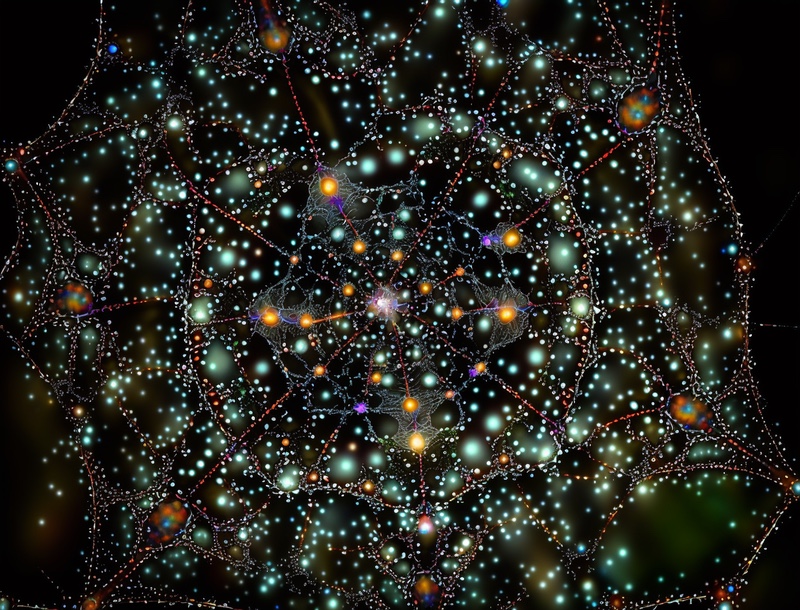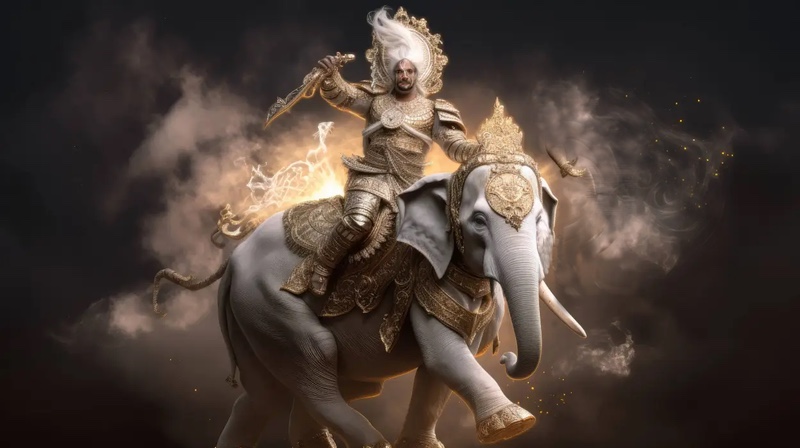
What is Indra’s Net and what does it represent? In this post, we’ll explore the spiritual and symbolic meanings of Indra’s Net, including what it signifies in Hinduism, Buddhism, and other spiritual beliefs, as well its association with ancient Egypt and sacred geometry.
Table of Contents

In Hindu cosmology, the god Indra is a powerful deity who is renowned for his strength, courage, and valiant feats. As the king of gods and ruler of the heavens, he governs the rain, thunderstorms, and war.
One of Indra’s most notable achievements is the defeat of the serpent monster Vritra, who embodies chaos. According to Hindu lore, this victory released life-sustaining rains and restored balance and harmony to the cosmos. Thus, Indra is also the guardian of cosmic order.

Indra’s Net is a gigantic and infinite net, or web, that spans the cosmos. According to Hindu mythology, the net hangs over Indra’s celestial palace on Mount Meru, which is the center of the Universe, or the axis of the world.1
Indra’s Net is introduced in one of the Vedas (ancient Hindu texts) called the Atharva Veda, which was written in Sanskrit around 1000 BCE.
Verse 8.8.6 of the Atharva Veda describes Indra’s Net this way:
“Vast indeed is the tactical net of great Indra, mighty of action and tempestuous of great speed. By that net, O Indra, pounce upon all the enemies so that none of the enemies may escape the arrest and punishment.”2
According to Hindu lore, Indra would use this net to trick and ensnare his enemies. He did so in order to preserve harmony and order on Earth.
In addition to being infinite in size, Indra’s Net has another exceptional aspect: At each node in the net is a glittering jewel. And each of these jewels has a mirror-like quality that reflects the other jewels. Thus, Indra’s Net is sometimes described as the Jeweled Net of Indra.
The jewels in Indra’s Net are like an infinite number of eyes, reflecting the deity’s power and all-knowingness.

While Indra’s Net was first written about around 1000 BCE, by the 3rd century, Buddhists had adopted the idea of Indra’s Net in their philosophy.
Buddhist scholar and professor Francis Dojun Cook (born Francis Harold Cook) describes Indra’s Net this way in his book Hua-yen Buddhism: The Jewel Net of Indra:
“Far away in the heavenly abode of the great god Indra, there is a wonderful net that has been hung by some cunning artificer in such a manner that it stretches out infinitely in all directions. In accordance with the extravagant tastes of deities, the artificer has hung a single glittering jewel in each ‘eye’ of the net, and since the net itself is infinite in all dimensions, the jewels are infinite in number.
There hang the jewels, glittering like stars of the first magnitude, a wonderful sight to behold. If we now arbitrarily select one of these jewels for inspection and look closely at it, we will discover that in its polished surface there are reflected all the other jewels in the net, infinite in number. Not only that, but each of the jewels reflected in this one jewel is also reflecting all the other jewels, so that there is an infinite reflecting process occurring.”3
Thus, in Buddhist philosophy, Indra’s Net represents the interconnectedness of everything in the Universe. And the jewels at each apex in the net, which have influence on all of the other jewels, represent the idea of cause and effect. This describes the Buddhist philosophy that every thought and every action matters as it has an effect on the whole.

Across the world, the ancient Egyptians also told stories about a cosmic net, which has synergies with Indra’s Net.
The Egyptians wrote about an invisible matrix of energy around the world that they described as a net. This net, or energy grid, was the source of everything that is manifested in the physical world.
Just as Indra’s Net originated from Mount Meru, the center of the Hindu Universe, the Egyptians believed their net emerged from their own power spot in Egypt. They also believed that this cosmic net separated the physical and metaphysical worlds.
In Egyptian beliefs, you could transcend the net at death. However, some souls would get caught in between the worlds.
Other people, or souls, had the power to transcend the net, or move back and forth between the physical and metaphysical realms.
These people were known as initiates, or netters, and they underwent extensive training to gain this capability. The Egyptians also believed that certain enlightened beings, which we describe as the many Egyptian deities, also had the power to move back and forth through the net.4 (We’ll go into more detail on the netters in another post!)

The theory behind sacred geometry is that it helps us to understand metaphysical concepts, energetic forms, and planes of existence that are beyond our physical world through the use of shapes and symbols.
In sacred geometry, Indra’s Net and the energy matrix described as a net by the ancient Egyptians help us to understand the concept of manifestation. We are not isolated beings; we are sources of energy that have an influence on the Universe.
As a metaphor and a sacred geometry concept, Indra’s Net represents real-world as well as spiritually profound ideas. Here are some examples:
Protection and Balance – Based on the traditional Hindu descriptions of who Indra was, his net symbolizes protection, balance, and order. Thus, Indra’s Net is a positive symbol or talisman for these concepts in our daily lives.
Our Bodies – Our bodies are also like a web, or net, where our cells and organs are like the jewels in Indra’s Net that are dependent on the connections with the other organs and cells.
Souls – On a spiritual level, the jewels, or nodal points, in Indra’s Net represent souls, or spirit cores.
While each soul is unique, it is part of an integrated whole. As Robert J. Gilbert, founder of the Vesica Institute describes in the Gaia documentary Sacred Geometry, “Each spirit core has the same divine essence as all others, but with their own unique qualities based on the karma they have generated through acting in the physical world.”

Biodiversity and Ecology – Indra’s Net can also symbolize the natural world, of which we are a part. The natural world is made up of connecting ecosystems, in which different species are interdependent on each other.
It’s virtually impossible to have a healthy species if the ecosystem of which it is a part is not healthy as well. In essence, each species is like a jewel in Indra’s Net that relies on the whole.
The Universe in Motion – The glittering jewels in Indra’s Net also reflect (no pun intended) that the Universe is not static; it is in a state of constant motion. This also plays into the Buddhist philosophy of impermanence. As the Buddhists say, “This too shall pass.”
We Are All Connected and Actions Matter – Indra’s Net also reminds us that we are part of the greater workings of the Universe. In our daily lives, our thoughts, words, and actions have an effect. As the Sufi poet Rumi wrote, “Stop acting so small, you are the Universe in ecstatic motion.”

Hello. Thanks for visiting UniGuide. My name is Kristen and I started UniGuide as a tribute to nature, animals, and spiritual exploration. I hope you enjoy your experience here!
UniGuide is dedicated to nature and animal lovers, spiritual seekers, and mythology fans.
©2025 UniGuide Media LLC
All Rights Reserved.
UniGuide participates in affiliate programs in which I may earn a small commission if you buy products you link to from UniGuide. Please see my Disclosures for details.
I donate 10% of UniGuide’s profits to animal welfare, wildlife conservation, and environmental charities. Learn more on About UniGuide.
UniGuide Media LLC
Sausalito, CA 94965
| Cookie | Duration | Description |
|---|---|---|
| cookielawinfo-checkbox-analytics | 11 months | This cookie is set by GDPR Cookie Consent plugin. The cookie is used to store the user consent for the cookies in the category "Analytics". |
| cookielawinfo-checkbox-functional | 11 months | The cookie is set by GDPR cookie consent to record the user consent for the cookies in the category "Functional". |
| cookielawinfo-checkbox-necessary | 11 months | This cookie is set by GDPR Cookie Consent plugin. The cookies is used to store the user consent for the cookies in the category "Necessary". |
| cookielawinfo-checkbox-others | 11 months | This cookie is set by GDPR Cookie Consent plugin. The cookie is used to store the user consent for the cookies in the category "Other. |
| cookielawinfo-checkbox-performance | 11 months | This cookie is set by GDPR Cookie Consent plugin. The cookie is used to store the user consent for the cookies in the category "Performance". |
| viewed_cookie_policy | 11 months | The cookie is set by the GDPR Cookie Consent plugin and is used to store whether or not user has consented to the use of cookies. It does not store any personal data. |